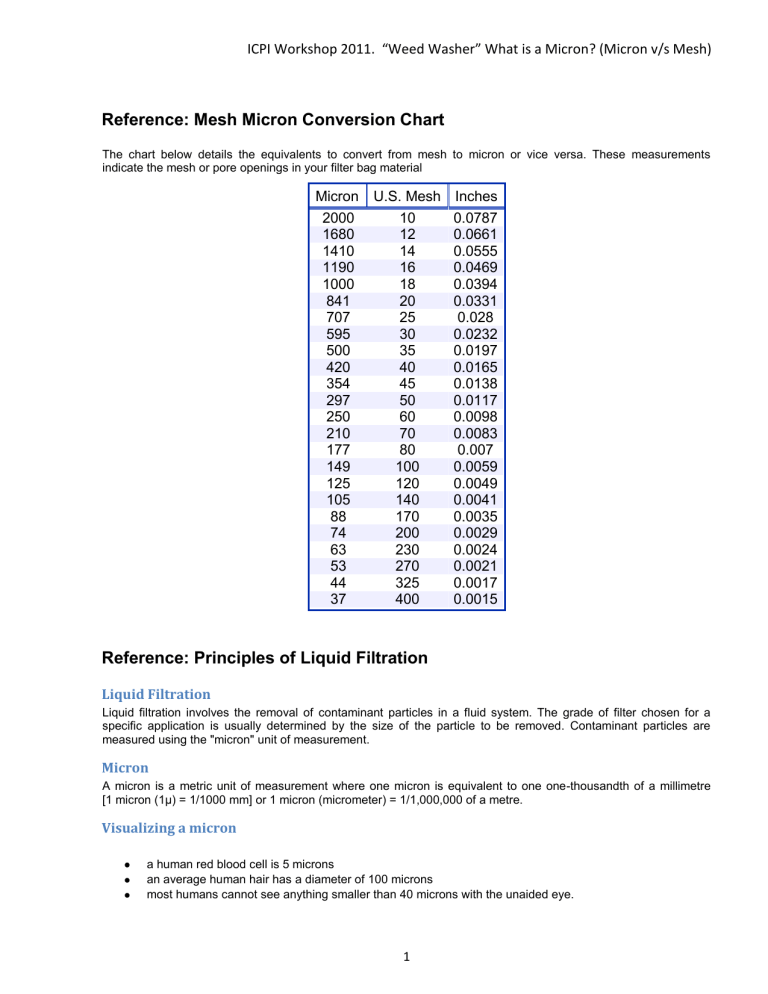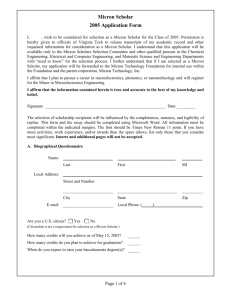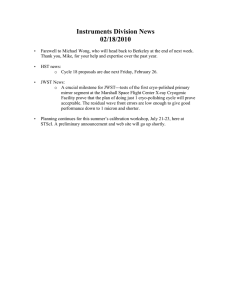Reference: Mesh Micron Conversion Chart

ICPI Workshop 2011. “Weed Washer” What is a Micron? (Micron v/s Mesh)
Reference: Mesh Micron Conversion Chart
The chart below details the equivalents to convert from mesh to micron or vice versa. These measurements indicate the mesh or pore openings in your filter bag material
Micron U.S. Mesh Inches
2000
1680
1410
1190
1000
841
707
595
500
420
354
297
88
74
63
53
44
37
250
210
177
149
125
105
0.0787
0.0661
0.0555
0.0469
0.0394
0.0331
0.028
0.0232
0.0197
0.0165
0.0138
0.0117
0.0098
0.0083
0.007
0.0059
0.0049
0.0041
0.0035
0.0029
0.0024
0.0021
0.0017
0.0015
20
25
30
35
40
45
50
10
12
14
16
18
170
200
230
270
325
400
60
70
80
100
120
140
Reference: Principles of Liquid Filtration
Liquid Filtration
Liquid filtration involves the removal of contaminant particles in a fluid system. The grade of filter chosen for a specific application is usually determined by the size of the particle to be removed. Contaminant particles are measured using the "micron" unit of measurement.
Micron
A micron is a metric unit of measurement where one micron is equivalent to one one-thousandth of a millimetre
[1 micron (1μ) = 1/1000 mm] or 1 micron (micrometer) = 1/1,000,000 of a metre.
Visualizing a micron
a human red blood cell is 5 microns an average human hair has a diameter of 100 microns most humans cannot see anything smaller than 40 microns with the unaided eye.
1
The following chart relates to size of some common particles:
Lower Limit Upper Limit
Contaminant
Micron Micron
1.0
1.6
3
4
5.5
0.3
0.4
0.55
0.7
7
10
75
0.4
0.55
0.7
1.0
1.3
2.2
4
5.5
7
10
75
1000
Smoke, Paint Pigments
Bacteria
Lung Damaging Paint
Atmospheric Dust
Molds
Flour Mill Dust
Cement Dust
Pulverized Coal
Commercial Dust
Pollen
Silt
Sand
The micron unit of measurement is used not only to measure the size of a contaminate particle, it is also used to measure the size of the openings in filter media, hence, a media's micron rating. This system of measurement is more accurate when gauging woven filtration structures, such as monofilaments, than it is for gauging non-woven structures, such as felts.
What is a Micron?
A micron is a unit of measure in the metric system. It equals one-millionth of a meter and one-thousandth of a millimeter. It is a shorten word for micrometer. m meter 39.37 inch dm decimeter 3.937 inch cm centimeter .3937 inch mm millimeter .03937 inch um micrometer .00003937 inch
Micrometers measure things that are very small. It is ideal for measuring things that are so small that the naked eye can barely see it. And it is ideal for measuring things so small that that the naked eye cannot see it. For example, airborne allergens such as pollen and mold spores usually fall just below the level of what the eye can see.
The word comes from the Greek word "Mikros" which means small.
The table below shows the placement of this unit of measure in the metric system.
You can see how small of a unit of measure that it is. If you were using a high power microscope or a SEM microscope and wanted to measure what you were looking at, the next unit of measure that is smaller is a nanometer. One thousand nanometers equals one micron.
The Unit-Length-Conversion website is a great website to convert to and from microns to other units of measure.
2
How to Visualize such a Small Unit of Measure
I will try to describe a visual picture to put such a small size into perspective. To know that 25,400 microns equals one inch is one thing.
To understand and to be able to visualize what that means is another.
To begin, I want to establish a point of reference that we can all relate to. Copy paper for the computer printer can vary in thickness. For this example, we will say that the average thickness of common copy paper is 100 microns . I arrive at this figure by measuring a ream of 500 sheets of paper. I take that measurement and divide by 500 and come up with a figure that is very close to .12 mm.
Pick up a piece of paper and look at the edge (the thickness) and you will see that the period at the end of this sentence is bigger.
The picture below represents the thickness of copy paper.
The horizontal line at top of the picture represents the top of the paper which is the writing side. The bottom line in the picture represents the bottom of the paper which would be the side that is touching the desk as you write.
Look at the edge thickness of a piece of paper and then look at the diagram above. This should help this small size into perspective.
If a piece of paper was lying flat on your desk, the right side of the picture above shows what a hundred microns would look like stacking upon top of each other along the edge (the thickness) of the paper.
This unit of measure makes it the ideal unit of measure for airborne allergens. As shown in the article Particle Sizes of Airborne
Allergens , most allergic airborne triggers range between 1-100 microns in size. And when talking about nasal allergies , the smaller the particle size, the more potential it has to stay airborne longer before settling. This results in more of a chance for the allergens to be breathed in.
3
MESH TO MICRON CONVERSION CHART
U.S. MESH
3
INCHES
0.2650
MICRONS
6730
MILLIMETERS
6.730
6
7
4
5
0.1870
0.1570
0.1320
0.1110
4760
4000
3360
2830
4.760
4.000
3.360
2.830
125
105
88
74
63
53
44
37
297
250
210
177
149
841
707
595
500
400
354
2380
2000
1680
1410
1190
1000
0.0117
0.0098
0.0083
0.0070
0.0059
0.0049
0.0041
0.0035
0.0029
0.0024
0.0021
0.0017
0.0015
0.0331
0.0280
0.0232
0.0197
0.0165
0.0138
0.0937
0.0787
0.0661
0.0555
0.0469
0.0394
120
140
170
200
230
270
325
400
50
60
70
80
100
20
25
30
35
40
45
8
10
12
14
16
18
0.125
0.105
0.088
0.074
0.063
0.053
0.044
0.037
0.297
0.250
0.210
0.177
0.149
0.841
0.707
0.595
0.500
0.400
0.354
2.380
2.000
1.680
1.410
1.190
1.000
4
Mesh Sizes and Microns
What does mesh size mean?
Figuring out mesh sizes is simple. All you do is count the number of openings in one inch of screen (in the United States, anyway.) The number of openings is the mesh size. So a 4-mesh screen means there are four little squares across one linear inch of screen. A 100-mesh screen has 100 openings, and so on. As the number describing the mesh size increases, the size of the particles decreases. Higher numbers equal finer material. Mesh size is not a precise measurement of particle size.
What do the minus (-) and plus (+) plus signs mean when describing mesh sizes?
Here’s a simple example of how they work. –200-mesh would mean that all particles smaller than 200-mesh would pass through. +200 mesh means that all the particles 200-mesh or larger are retained.
How fine do screens get?
That depends on the wire thickness. If you think about it, the finer the weave, the closer the wires get together, eventually leaving no space between them at all. For this reason, beyond 325-mesh particle size is usually described in “microns.”
What is a micron?
A micron is another measurement of particle size. A micron is one-millionth of a meter or one twenty-five thousandth of an inch.
Sieve Mesh # Inches Microns Typical Material
14 .0555 1400 -
28
60
100
.028
.0098
.0059
700
250
150
Beach Sand
Fine Sand
-
200
325
400
(1200)
.0029
.0017
.0015
.0005
74 Portland Cement
44
37
12
Silt
Plant Pollen
Red Blood Cell
(2400)
(4800)
.0002
.0001
6
2
-
Cigarette Smoke
The mesh numbers in parentheses are too small to exist as actual screen sizes; they are estimates included for reference.
5







